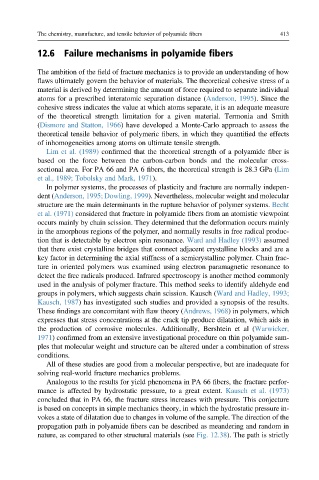Page 440 - Handbook of Properties of Textile and Technical Fibres
P. 440
The chemistry, manufacture, and tensile behavior of polyamide fibers 413
12.6 Failure mechanisms in polyamide fibers
The ambition of the field of fracture mechanics is to provide an understanding of how
flaws ultimately govern the behavior of materials. The theoretical cohesive stress of a
material is derived by determining the amount of force required to separate individual
atoms for a prescribed interatomic separation distance (Anderson, 1995). Since the
cohesive stress indicates the value at which atoms separate, it is an adequate measure
of the theoretical strength limitation for a given material. Termonia and Smith
(Dismore and Statton, 1966) have developed a Monte-Carlo approach to assess the
theoretical tensile behavior of polymeric fibers, in which they quantified the effects
of inhomogeneities among atoms on ultimate tensile strength.
Lim et al. (1989) confirmed that the theoretical strength of a polyamide fiber is
based on the force between the carbon-carbon bonds and the molecular cross-
sectional area. For PA 66 and PA 6 fibers, the theoretical strength is 28.3 GPa (Lim
et al., 1989; Tobolsky and Mark, 1971).
In polymer systems, the processes of plasticity and fracture are normally indepen-
dent (Anderson, 1995; Dowling, 1999). Nevertheless, molecular weight and molecular
structure are the main determinants in the rupture behavior of polymer systems. Becht
et al. (1971) considered that fracture in polyamide fibers from an atomistic viewpoint
occurs mainly by chain scission. They determined that the deformation occurs mainly
in the amorphous regions of the polymer, and normally results in free radical produc-
tion that is detectable by electron spin resonance. Ward and Hadley (1993) assumed
that there exist crystalline bridges that connect adjacent crystalline blocks and are a
key factor in determining the axial stiffness of a semicrystalline polymer. Chain frac-
ture in oriented polymers was examined using electron paramagnetic resonance to
detect the free radicals produced. Infrared spectroscopy is another method commonly
used in the analysis of polymer fracture. This method seeks to identify aldehyde end
groups in polymers, which suggests chain scission. Kausch (Ward and Hadley, 1993;
Kausch, 1987) has investigated such studies and provided a synopsis of the results.
These findings are concomitant with flaw theory (Andrews, 1968) in polymers, which
expresses that stress concentrations at the crack tip produce dilatation, which aids in
the production of corrosive molecules. Additionally, Bershtein et al (Warwicker,
1971) confirmed from an extensive investigational procedure on thin polyamide sam-
ples that molecular weight and structure can be altered under a combination of stress
conditions.
All of these studies are good from a molecular perspective, but are inadequate for
solving real-world fracture mechanics problems.
Analogous to the results for yield phenomena in PA 66 fibers, the fracture perfor-
mance is affected by hydrostatic pressure, to a great extent. Kausch et al. (1973)
concluded that in PA 66, the fracture stress increases with pressure. This conjecture
is based on concepts in simple mechanics theory, in which the hydrostatic pressure in-
vokes a state of dilatation due to changes in volume of the sample. The direction of the
propagation path in polyamide fibers can be described as meandering and random in
nature, as compared to other structural materials (see Fig. 12.38). The path is strictly

